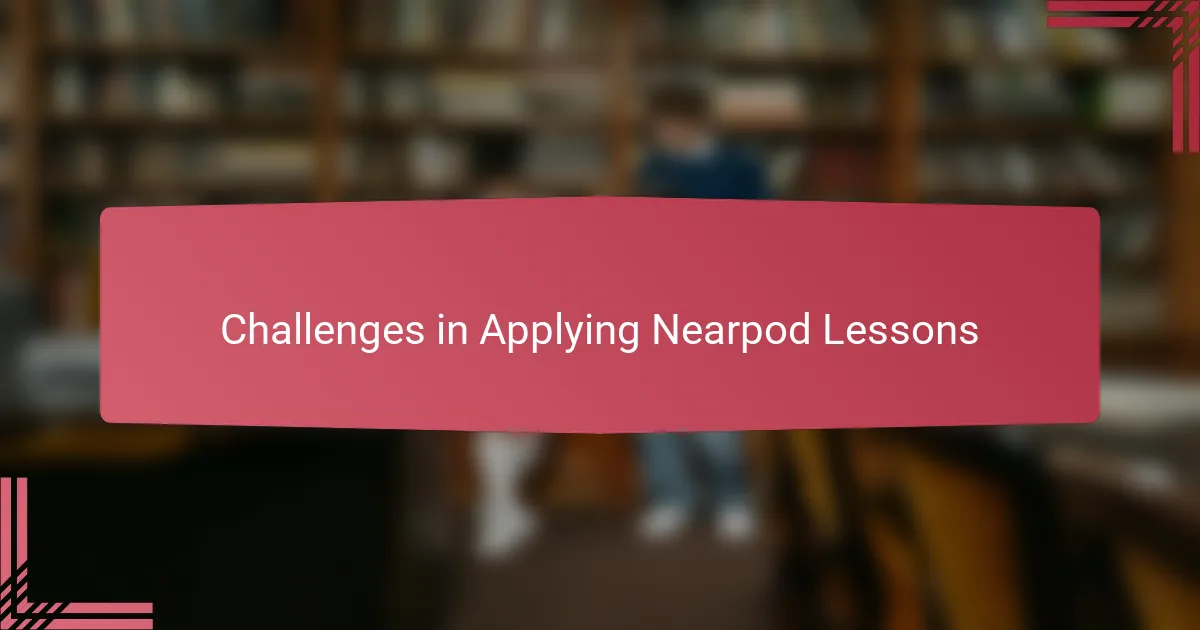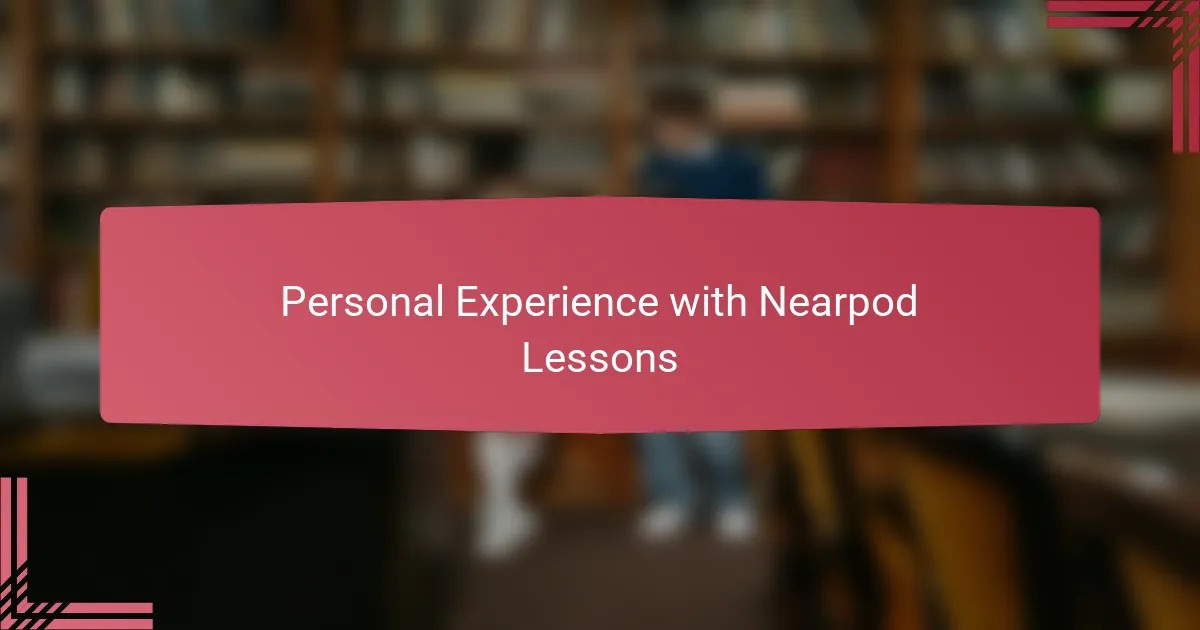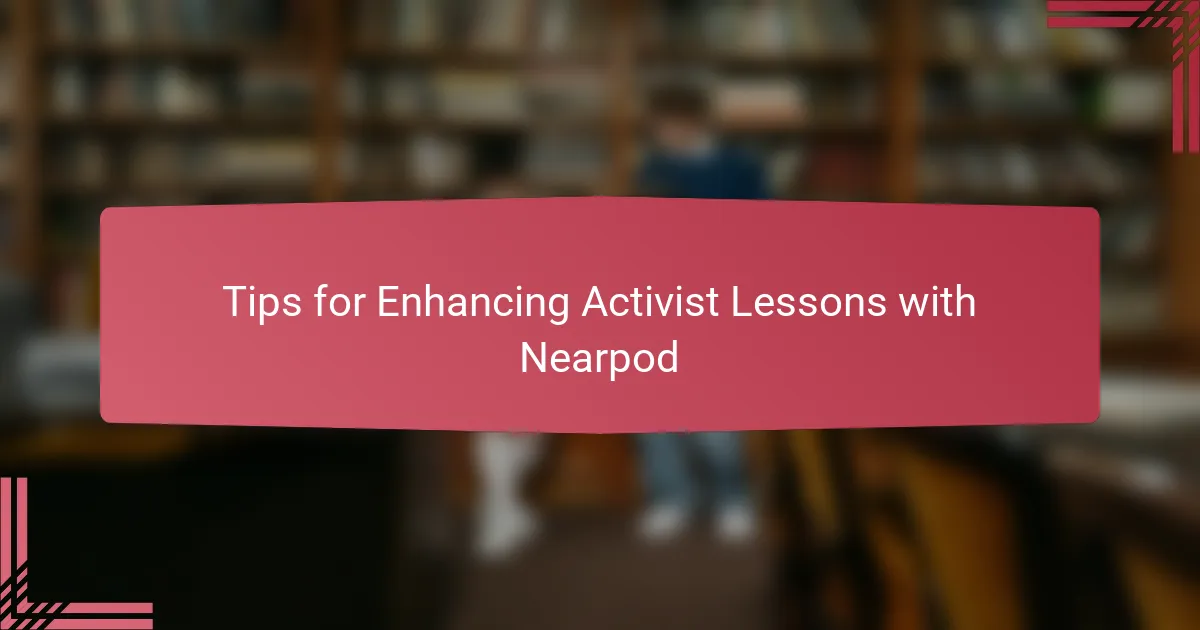Key takeaways
- Activist teacher resources empower students to engage critically with social justice issues, transforming education into a form of activism.
- Nearpod’s interactive features enhance student participation and emotional connection, allowing for immediate feedback and meaningful discussions.
- Challenges in using technology include reliance on internet connectivity and maintaining balance between screen time and personal interaction.
- Incorporating local and cultural artifacts into lessons increases student engagement and makes the content more relatable and impactful.

Understanding Activist Teacher Resources
When I first encountered activist teacher resources, I didn’t fully grasp their power beyond lesson plans. But over time, I realized they are tools that challenge the status quo and encourage critical thinking about social justice. Have you ever felt the frustration of teaching content that ignores the realities your students face? That’s exactly where these resources step in.
Using activist materials means more than just sharing facts; it’s about fostering empathy and empowering students to question and act. I remember a lesson where incorporating such resources sparked deep conversations in my classroom that wouldn’t have happened otherwise. It made me see how education can be a form of activism itself.
Isn’t it interesting how the right materials can transform a classroom atmosphere? Activist teacher resources don’t just inform; they inspire. They make education a living, breathing process where students can connect with their community and the world on a deeper level.

Overview of Nearpod Interactive Lessons
Nearpod’s interactive lessons caught my attention because they blend technology with engagement in a way that feels natural. Have you ever tried to keep a whole classroom focused while reading a long text or watching a video? Nearpod’s interactive features, like quizzes and polls embedded right into the content, make it easier to hold students’ attention and check their understanding on the spot.
What really stood out to me was how flexible these lessons are. Whether I wanted to customize content or add my own activist materials, the platform allowed me to tailor the experience without losing the flow of the lesson. That adaptability made me feel more confident in delivering meaningful discussions, knowing I had tools that could actively involve every student.
Using Nearpod, I noticed a shift—not just in participation, but in how students responded emotionally. They weren’t just passive listeners anymore; they were actively reflecting and connecting with the topics. Isn’t that the kind of engagement every teacher hopes for? From my experience, Nearpod’s interactive lessons can be a powerful way to bring activist teaching to life.

Benefits of Using Nearpod for Activism
One of the biggest benefits I’ve found using Nearpod for activism is how it turns abstract issues into something tangible. When students interact with polls or open-ended questions right in the lesson, their voices become part of the dialogue. Have you ever witnessed a quiet student suddenly light up because their opinion mattered? That moment of participation felt like a small act of empowerment in my classroom.
Nearpod also helps me create a safe space for difficult conversations. The anonymity some features offer encourages students to share honestly without fear of judgment. I recall a lesson on systemic inequality where several students shared personal experiences through the platform’s chat, opening a window to realities I hadn’t fully appreciated before. That vulnerability transformed the lesson into a genuine exchange rather than just a lecture.
And let’s not forget the immediacy of feedback. Nearpod’s real-time insights into students’ understanding mean I can pivot instantly—whether that’s clarifying misconceptions or diving deeper into a topic that sparked passion. Have you ever felt stuck wondering if your message is landing? With Nearpod, I don’t have to guess. That responsiveness makes activism through teaching feel alive and responsive.

Challenges in Applying Nearpod Lessons
One challenge I’ve faced with Nearpod lessons is the reliance on technology—what happens when internet connections falter or devices lag? I remember a day when a student’s tablet froze right at a pivotal moment, and suddenly, the seamless flow I counted on was disrupted. Doesn’t that make you wonder how much tech dependency can impact the spontaneity of meaningful discussions?
Another hurdle involves balancing screen time with authentic human interaction. While I love how interactive Nearpod can be, sometimes I worry it might unintentionally create a barrier between students and face-to-face dialogue. Have you ever noticed students more focused on clicking through activities rather than engaging deeply with one another? Finding that sweet spot takes constant tweaking and reflection.
Lastly, customization, though a strength, can also overwhelm. I’ve spent hours tailoring lessons to fit activist themes perfectly, only to realize the platform’s limits don’t always capture the nuance I want to convey. It makes me ask: How do we maintain the integrity of complex social issues within any digital format without losing the depth those conversations deserve?

Personal Experience with Nearpod Lessons
Using Nearpod in my classroom felt like opening a door to new interactions I hadn’t seen before. I remember one lesson where a shy student, usually quiet during discussions, eagerly participated in a poll and shared a thoughtful reflection afterward. Doesn’t it amaze you how a simple digital tool can give voice to those who often stay silent?
There was also a moment when I noticed the energy in class shift—students weren’t just completing tasks; they were wrestling with ideas and connecting them to their own lives. That kind of engagement made me realize Nearpod isn’t just about technology; it’s about creating a space where learning feels dynamic and personal.
Of course, not every experience was flawless. Sometimes, glitches would interrupt the flow, and I found myself improvising on the spot. But even then, those challenges pushed me to rethink my approach and reminded me that authentic connection goes beyond any platform. Have you ever found that adapting mid-lesson led to unexpected, meaningful conversations? I definitely have.

Tips for Enhancing Activist Lessons with Nearpod
When enhancing activist lessons with Nearpod, I’ve found that integrating frequent pauses for reflection truly deepens student engagement. Have you ever tried embedding quick polls or open-ended questions after a powerful video clip? Those moments create breathing room for students to process complex ideas and share their personal perspectives without feeling overwhelmed.
Another tip is to use Nearpod’s collaborative boards to foster genuine dialogue. I once invited my class to post responses about community activism, and watching their ideas build on each other in real time was inspiring. Isn’t it amazing how technology can sometimes bring out the kind of peer-to-peer conversations we crave in activist classrooms?
Lastly, don’t hesitate to customize lessons with artifacts that resonate locally or culturally. I learned that when students see their own realities reflected in the material, their connection to activism intensifies. Nearpod’s flexibility made it easy for me to insert images, news clips, and quotes that sparked more meaningful debates than generic content ever could. Have you noticed how adding that personal touch turns a lesson from informative to transformative?